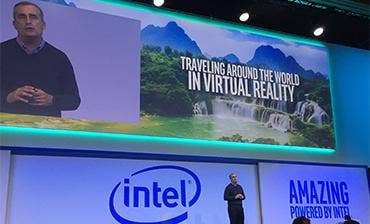CES 2017: Intel Shows Off Compute Prowess In Virtual Reality, Outlines Project Alloy Road Map

Intel CEO Brian Krzanich's focus in his CES keynote this year wasn't on processors but instead on how the chip giant is providing the compute power behind today's coolest virtual reality experiences.
"We believe [VR] is a game-changer," Krzanich said to an audience at CES, which kicks off this week in Las Vegas. "We can't talk about virtual reality without talking about merged reality. It's being driven by technology that Intel has been developing, like RealSense and our Project Alloy."
Intel's Project Alloy is an all-in-one merged reality headset providing an immersive experience with RealSense technology. Krzanich said the headset, first launched in August, will start to be productized in the fourth quarter of 2017 through Intel's partners.
[Related: 30 Cutting-Edge Products On The CES Unveiled Show Floor]
The headset features two RealSense cameras, integrated computing capabilities, vision sensors and a battery.
Project Alloy capitalizes on the concept of merged reality – a combination of virtual and augmented reality – which means that users can see others using the headset, and there is seamless tracking built into it that enables a physical room to transform into a virtual room.
Krzanich stressed the importance of virtual reality in various areas: "The physical and visual worlds are emerging," he said. "We want to show how travel is changed by VR, how work is changed by VR, and how gaming is changed by VR."
For instance, virtual reality can have an impact in a work setting with solar panel inspectors, said Krzanich. Solar panels need to be inspected regularly – but if VR capabilities are added to a drone the inspectors can look wherever they want in 360 degrees, enabling the inspection to be executed remotely.
Ted Schilowitz, co-founder of HypeVR, an Intel partner based in San Diego, said his company has made what it calls the first walk-around VR experience -- so that users can actually move around within a virtual reality environment – and Intel technology is at the heart of that experience.
"We want to advance the concept of what video is at its core," said Schilowitz. "This requires massive amounts of computing, which is why we partnered with Intel."
Intel, Santa Clara, Calif., also is trying to change the game around how virtual reality impacts sports and entertainment. In 2016, the company acquired virtual reality startup Voke and is working to enable VR enthusiasts to watch sports games live – in virtual reality.
"You can be transformed to a sporting event, a concert, or even the front seat of an awards show," stressed Krzanich.
Moving forward, Krzanich stressed Intel's future plans to continue to invest in virtual reality experiences.
"With any new technology, it's always been about hardware and software, or content," he said. "We think these experiences are where virtual reality is going."